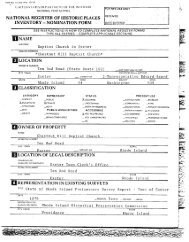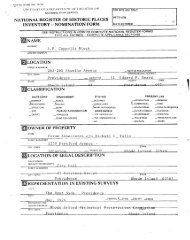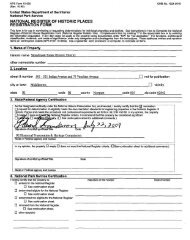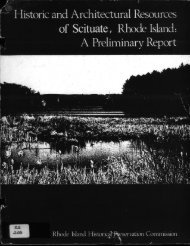1 Dr. Jonathan Prude, Emory University “The Great Transformation ...
1 Dr. Jonathan Prude, Emory University “The Great Transformation ...
1 Dr. Jonathan Prude, Emory University “The Great Transformation ...
Create successful ePaper yourself
Turn your PDF publications into a flip-book with our unique Google optimized e-Paper software.
6secure what was termed a “sufficiency,” not to get-ahead but to retain their holdings and hencetheir place within New England husbandry.Thus the world of southern New England rural communities in the late 18th and early19th centuries. But this world was also beset by important destabilizing pressures. To start with,there was the growing pull of commerce. Because notwithstanding their desire for sufficiency, itwas becoming increasingly attractive to buy services from others and, especially, to buy goodsfrom stores. And there was consequently growing need to generate the added income to coverthese added purchases--a challenge exacerbated for farmers because even those inclined to sellmore crops in the market were not certain their long-used land could generate greater yields orproduce items that would attract more customers. By the same token, the slow but steadypopulation growth of these communities was pressing against fixed land supplies, so that manyfamilies were finding it impossible to bequeath viable homesteads to all their children. The resultof this demographic pressure was in some cases a greater emphasis on the non-agriculturalventures in these townships. But the result was also movement--either to cities or to new landfurther out in the hinterland. Natural increase and infusions of newcomers (often to run the localstores and handicraft shops) ensured net increases of local residents. But at least by the early1800s the northeastern countryside, including the countryside of southern New England, wasmarked by chronic restless movings-about.All this--the need for more income, the uncertainty about farming outputs, the transiency--all these pressures, I’d suggest, invested rural Yankee communities with a certain deep fragilityand doubt. How could they preserve their heritage of husbandry and in truth any continuingsense of themselves amidst the buffeting shifts of life and work engulfing them?One answer, significantly, was industrialization. Now on the one hand the spread ofindustrialized manufacturing helped provide the very goods fostering the unsettling desire ofcountry folk for store-bought “stuff.” In truth, the spread of industrially produced goods into thehinterland may have fostered a measure of material democratization whereby items--clocks, say--hitherto available only to the rustic wealthy were now produced sufficiently cheaply to come















